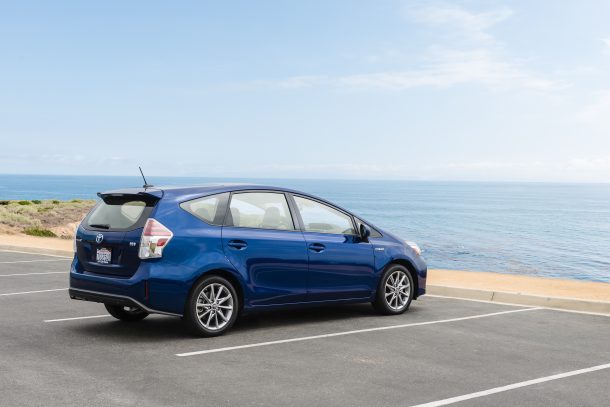Another Hybrid Bites the Dust: Toyota Prius V Packs It in After VI Model Years

Okay, the “V” stood for “versatility,” but the largest Toyota Prius family member’s obvious usefulness hasn’t earned it a lasting place in the American automotive landscape. After arriving for the 2012 model year, the lengthened hybrid, which boasted 50 percent more interior volume than its Prius sibling, will disappear from the U.S. after 2017.
Early sales of the Prius V significantly bolstered the volume of the hybrid family, which also includes the Vrtucar-approved Prius C. However, the model’s first full year of sales proved to be the V’s high water mark. Sales declined each year thereafter, and much of the blame rests on another vehicle in the Toyota showroom.
Confirmed by Green Car Reports, the 2017 model year will be the Prius V’s last in the U.S. and Puerto Rico.
“After six years and nearly 160,000 units sold in the U.S., the decision was made to end Prius V production for the U.S. and Puerto Rico this December,” said Toyota’s East Coast communications manager, Corey Proffitt.
Marketed as a midsize MPV in its home market, the Prius V appeared as a large-ish five-door variant of the popular third-generation Prius. Indeed, the model was larger in all dimensions. Five inches longer and an inch wider that a stock Prius, the V offered more legroom and headroom, especially in the rear, and offered 34.3 cubic feet of rear cargo area. That meant a 10-cubic-foot gain over an entry-level Prius.
Naturally, the nameplate’s renowned fuel economy suffered. At the time of its debut, the EPA assigned a combined fuel efficiency rating of 42 miles per gallon, some 8 mpg less than its smaller sibling. American sales in 2012 amounted to 40,669 units, dropping to 14,840 in 2016. Over the first 10 months of 2017, sales are down 33 percent compared to the same period last year.
So, why did it suddenly become so hard to sell a hybrid?
Besides the pressure placed on traditional hybrids by their sexier plug-in rivals, the second year of U.S. Prius V production coincided with the introduction of Ford’s C-Max, in both hybrid and plug-in form. ( Say goodbye to the C-Max while you’re shedding a tear over the Prius V.)
The biggest blow to the Prius V came from within the Toyota family, however. The downfall of the wagon-ish Prius V came as the popularity of compact crossovers soared, and America’s most popular hybrid crossover just happens to be the RAV4 Hybrid. Despite travelling nearly 10 fewer miles per gallon on the combined cycle, the RAV4 hybrid has three things even green car buyers can’t resist: a taller ride height, all-wheel drive, and a brawnier appearance.
Many of the 45,000 sales recorded in the RAV4 Hybrid’s first model year (2016) likely came from buyers who, a few years earlier, would have happily driven home in a Prius V.
Proffitt claims the Prius V, built on the older New MC platform (the fourth-gen Prius adopts Toyota’s TNGA modular platform), will continue in some markets. Assume a long life in Japan, where the model remains a raging success. As of press time, TTAC hasn’t been able to confirm the Prius V’s departure from the Canadian market, though the model remains the only Toyota vehicle that hasn’t adopted 2018 pricing on the division’s website.
[Image: Toyota]

More by Steph Willems
Latest Car Reviews
Read moreLatest Product Reviews
Read moreRecent Comments
- Fred I like the digits for the speedometer, simple easy to read.
- Fred My TLX has a trunk with no hooks for a net so I got one of those trunk organizers. Just a cheap one from Amazon. Something to keep the groceries from sliding and spilling all over.
- Kjhkjlhkjhkljh kljhjkhjklhkjh its not even 2026 yet ... recall
- Mnemic Muscle cars are the only CARS still selling. Look up top 10 coupe sales from 5-6 years ago. Damn corvettes were outselling 2 door honda civics. Mustang, Challenger and Camaro were top 3 and by a huge margin, nothing else came close. With Charger being so huge there is room for Dodge to make a smaller coupe
- D i wonder if the geniuses who thought building an aluminum body truck still think it’s a great idea.



































Comments
Join the conversation
In my neck of the woods, this is called the Prius+ and it loses basically no value. One of the best new cars to buy if you are concerned about resale. I have been considering replacing my Honda Stream with a Prius+, but I've never driven one and they are too pricey to buy to make any sense.
Honestly if this thing had the third row it does in Japan and came with the hybrid powertrain from the Camry with a little more oomph it'd have sold a LOT better.